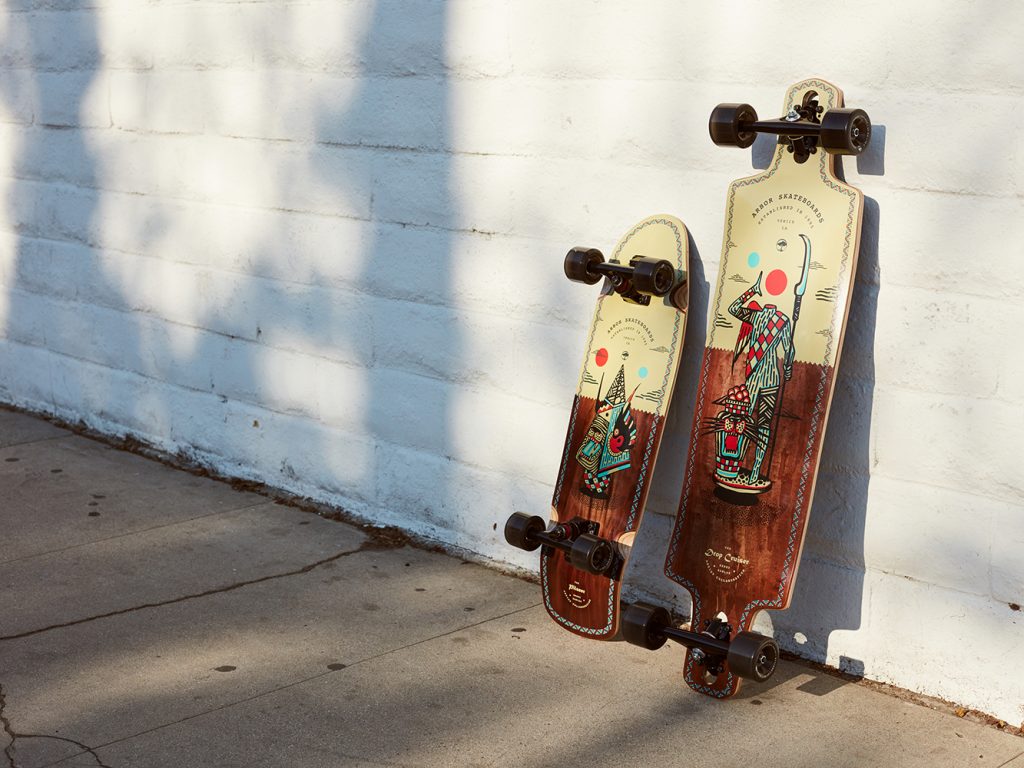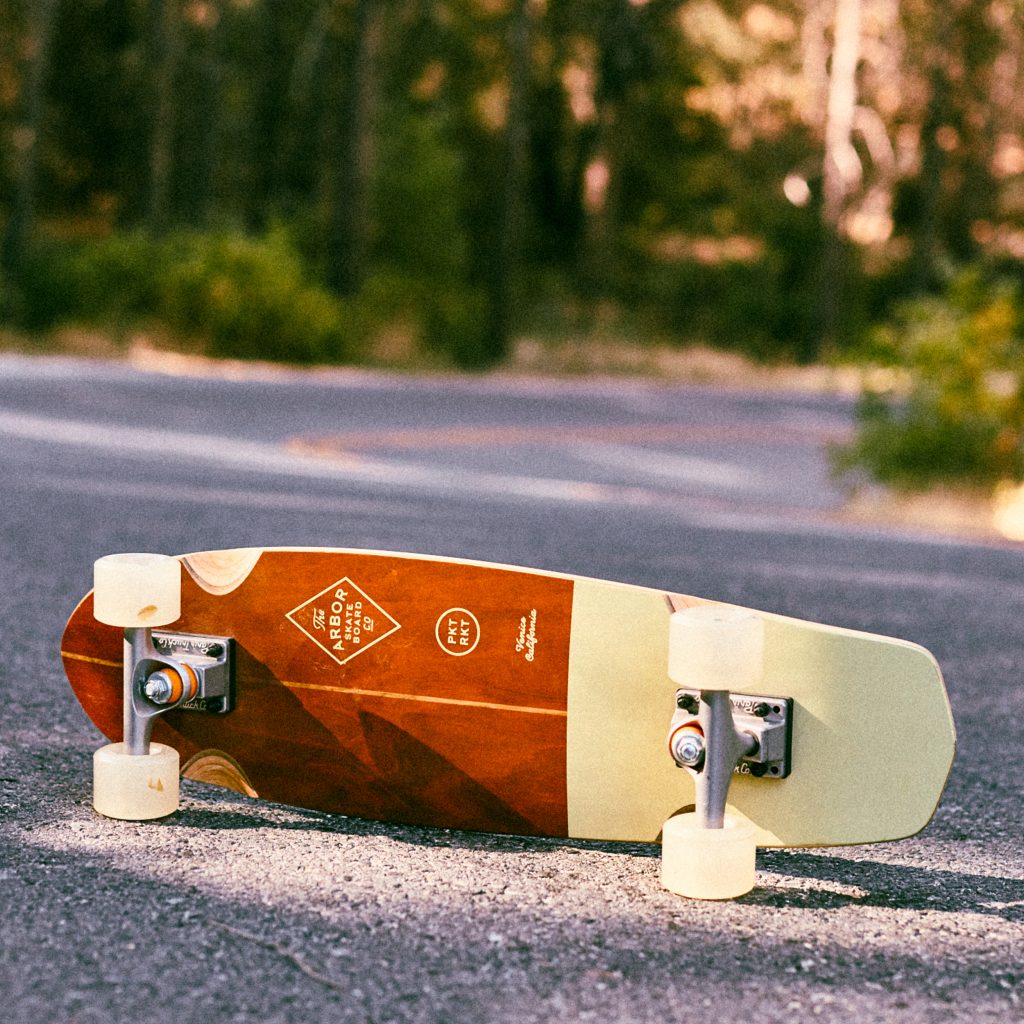Maybe you’ve cruised around on a friend’s longboard, maybe you’re a skateboarder who wants a more efficient way of getting around, maybe you’re just chasing that carvy experience of surfing, whatever your reason is for purchasing your first longboard, it doesn’t take long to realize that there are almost as many shapes, styles, and sizes of longboards as there are riders. This guide will help you break down your decision based on what longboard will work best for you.
Most beginners should be looking at “complete” boards. This means boards that come as a package with a deck, grip tape, wheels, trucks, and bearings. That way you won’t have to worry about compatibility issues or putting it all together correctly. Then, once you’ve figured out what sort of riding style appeals to you, you can upgrade specific components to match it.

Navigate the article
Shape
The first decision when looking for your first longboard is shape. There are two main groups of longboards based on shape, directional and symmetrical.
Directional boards look more like what you’d typically imagine as a longboard, they have an obvious front and back end – they come in a variety of shapes including swallowtails, pintail longboards, and kick tails. Symmetrical boards, as the name implies, are shaped the same on both ends. This allows the rider to perform 180° spins and other tricks. In broad terms, directional boards are better suited to riders looking to cruise or carve around on their boards, whereas riders interested in learning freestyle tricks should look at symmetrical boards.
A directional board will be the best choice for most beginners since they are usually a little easier to maneuver at lower speeds and have a more gradual learning curve. Within this category there are still several shape options. Many cruising longboards are a pin tailed shape, this asymmetrical flex pattern and shape is perfect for beginners who just want to get a hang for carving and turning. Boards like the Arbor Fish Groundswell fit the bill nicely here. However, if you have some experience with a traditional skateboard, a kicktail shape is a good option since it allows you to brake and ollie your longboard more like you would on a regular skateboard.

Size
There are a huge variety of sizes available for longboards. The general rule of thumb is that longer boards are more stable at high speeds, but less maneuverable. Shorter boards are more twitchy, but also easier to turn in tight spaces and at lower speeds. Decide your size based on what you want from the board, and where you live.
Want to bomb huge hills all over campus? Go for a longer board. Want to cruise crowded and generally flat city streets? Look for something shorter. Size is also relative to your height and weight. A bigger person will have no problem turning a longer, stiffer board, whereas someone more petite should be looking at shorter, softer boards. A board in the 34-42” size range will work well for most beginners.
Truck Type
There are several styles of longboard trucks. The most common are top, drop though, and drop deck. Top mounted trucks look like those found on a traditional skateboard. They mount to the bottom of the deck, and hold the board higher off the ground. Top mounted trucks are a great choice for many beginners looking for their first board. They’re generally pretty easy to turn and work well with a wide range of speeds and styles
Drop through trucks bring the board closer to the ground, they lower its center of gravity, which makes the board easier to push, and more stable at speed. However, it’s a little harder to carve and turn a board at low speeds with drop through trucks, which mean they might be a little challenging for some beginners.
Drop deck trucks are usually found on more advanced boards, and they work in conjunction with a molded deck to bring the board’s center of gravity very low. This makes the board very stable, and allows it to make aggressive carves, which is great for racing and freestyle tricks.
Whatever style of trucks you end up going with, remember that they are adjustable, both by loosening their kingpin, and by swapping different hardnesses of their bushings. This allows you to tune how easy the board is to lean over and carve. Softer, looser trucks will allow you to really lean into turns, whereas stiffer, tighter trucks will be more stable at higher speeds.
Wheels
The final part of your longboard is wheels. Most complete boards will come with a good all-round set of wheels that will work well in a variety of situations. Once you’ve worn out that first set of longboard wheels you can really dive into tuning your board’s ride. There are a huge variety of sizes and hardnesses that allow you to fine-tune how easy to slide and drift your board is, how well it deals with rough roads, and how long the wheels last before they need to be replaced.
Got that all? It might be a lot to digest at first, but remember to start with the shape of the board and go from there. Still not sure about which shape you want? Check out our guide to longboard shapes. But most of all, remember to have fun out there surfing those concrete waves!
We are evo – a ski, snowboard, mountain bike, surf, wake, and skate retailer based in Seattle, Washington, USA, with stores located in Seattle, Portland, and Denver. We also offer trips to remote locations across the globe in search of world-class powder turns, epic waves, and legendary mountain biking through our evoTrip adventure trip packages.
This post was created with our nice and easy submission form. Create your post!








